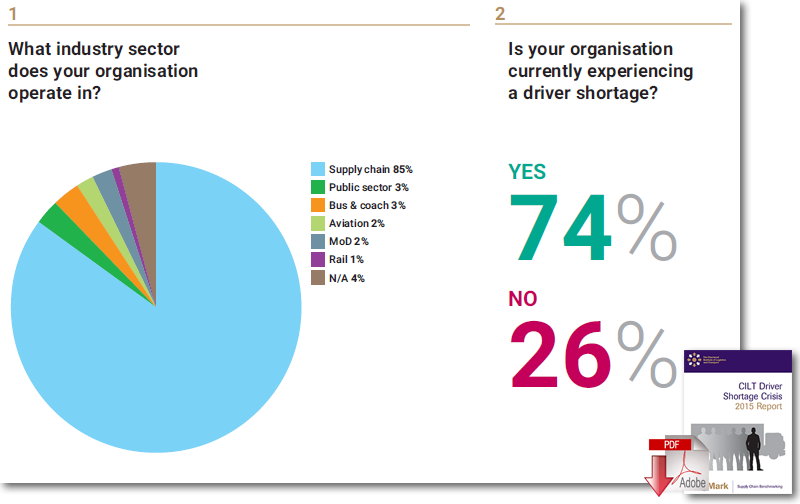A Wake-Up Call For Industry As Truck Driver Shortage Reaches Crisis Point In The UK

A survey of leading UK companies on behalf of the Chartered Institute of Logistics and Transport (CILT) has highlighted the crisis faced in the supply chain from a worsening heavy goods vehicle (HGV) driver shortage.
Over 100 companies were surveyed to support the CILT’s Driver Shortage Crisis publication, including retailer Marks & Spencer, Premier Foods and haulage group Norbert Dentressangle.
The results will serve as an alarming wake-up call for the UK’s transport industry and confirmed earlier fears expressed of a “ticking time bomb” of driver shortages and also that the shortage has now reached crisis point in many regions of the UK.
Indeed, 74% of respondents stated that their organisations were experiencing a driver shortage and 61% said they were obliged to rely on agency drivers to cover their regular workload commitments.
The problems stem firstly from the high cost of entry in terms of licence acquisition and thereafter from a new EU directive requiring drivers to obtain a Certificate of Professional Competence (CPC).
Maintaining a CPC involves 35 hours of training every five years and has been described many times to The Loadstar by HGV drivers as the “final straw” in their decision, already under consideration due to the long and unsociable hours and poor wages, to walk away from the industry. These factors have also seen younger workers shun the job as a career.
CILT Driver Shortage Crisis Report
The supply chain benchmarking club of the leading professional logistics and transport body, The Chartered Institute of Logistics and Transport, has today published findings from a recent Logmark survey addressing the current driver shortage.
Over 100 participants from companies including; Norbert Dentressangle, Marks & Spencers, Doddle, Mark Thompson Transport Ltd and Premier Foods, took part in the survey and the Institute will use the findings to inform the debate.
The Institute will be hosting a series of round table discussions where senior industry figures can share best practice, solutions and innovative thinking in dealing with the associated issues.
Some of the key findings of the survey include:
- 74% of members surveyed stated that their organisation is experiencing a driver shortage
- The survey revealed that the driver shortage is a UK wide issue
- 61% of those surveyed revealed that they use agency workers regularly throughout the year
- 51% of organisations surveyed have failed to recruit driver
- s over the last 12 months
- The average age of the participant’s driver was revealed as 47 years old
- 58% of organisations surveyed are not recruiting any trainee drivers
- 22% of those surveyed do not finance Driver CPC for their drivers and 56% do not provide in-house training for goods vehicle licence acquisition
- Nearly 60 members claimed that industry image and perception is a significant factor in the driver shortage
- 89% of those surveyed think the Government is not doing enough to highlight and deal with the driver shortage crisis
- 80% claimed it is the responsibility of business to find solutions to the issue
As a consequence, the average age of UK HGV drivers has climbed to 47, with a severe shortage of younger people coming through to replace them when they either hand in their keys in favour of a less stressful job, or retire.
Of those companies surveyed, 80% accepted that it was their responsibility to find solutions to the issues, but 89% complained that the UK government was not doing enough to highlight and deal with the current driver shortage crisis.
As a proactive response to the survey, CILT said it would host a series of nationwide round-table discussions, at which senior industry figures could share best practice and brainstorm ideas to combat the issues.
Container haulage shortages are yet another challenge for the UK’s supply chain already burdened by the erratic scheduling of ocean carriers and pinch points at container terminals caused by the bunching of bigger ships with considerably higher box exchanges.
Furthermore, the sub-economic freight rates that many liner operators are now are obliged to work with – the consequence of a bloody rate war raging in Asia – leaves little scope for the carriers to concede any haulage rate increases that would assist companies to raise the remuneration of drivers.
Indeed, one Felixstowe-based carrier bizarrely told its customers in an advisory that the reason for a lack of prompt haulage was that they (the shippers) had “squeezed us to reduce costs and we have squeezed our suppliers, of which transport companies are one”.
A shortage of truck drivers is a problem that the UK has in common with several European nations and has also become a serious issue in the US, for similar reasons of low pay and industry standing with fewer young people are interested in getting into the profession.
Indeed, according to the American Trucking Association (ATA) there is currently a shortage of 30,000 truck drivers across the nation. From the ATA’s own findings, 90% of hauliers cannot find enough drivers for their needs.
Related: Driver Shortage Issues Remain Intact Based on ATA Driver Turnover Data
Source: The LoadStar
Image: HR Virtuoso
Related: Aging Truck Driver Work Force - A Major Issue in Filling Demand & Empty Seats

Article Topics
Chartered Institute of Logistics & Transport CILT News & Resources
CILT Driver Shortage Crisis Report A Wake-Up Call For Industry As Truck Driver Shortage Reaches Crisis Point In The UKLatest in Transportation
City of Baltimore Files Lawsuit to Recoup Money for Collapsed Bridge The Era of Self-Driving Tractor-Trailers Set to Begin Is the Trailers as a Service (TaaS) Model Right For Your Business? Why Grocery Shoppers are Leaving Stores to Buy Their Food Online Unlocking Efficiency: Navigating Sea Freight Logistics in Supply Chain Management Is There a Next Generation of Truckers? Data Reveals Grim Outlook A Look at Baltimore’s Key Bridge Collapse—One Month Later More Transportation













